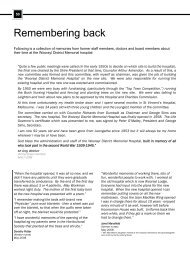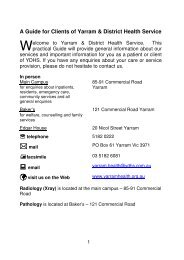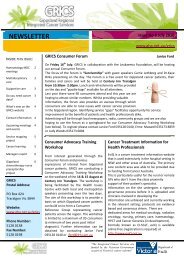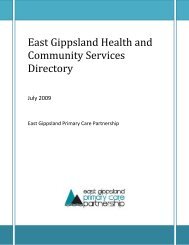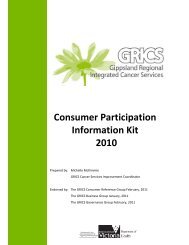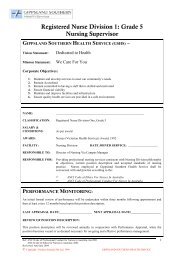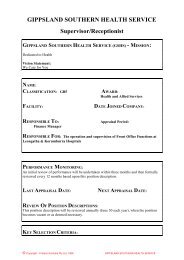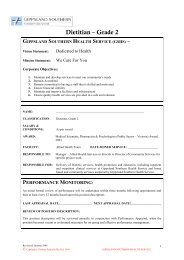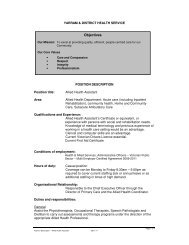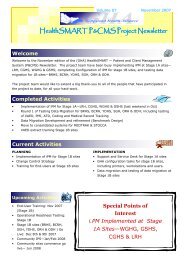Building for a brighter future - GHA Central
Building for a brighter future - GHA Central
Building for a brighter future - GHA Central
Create successful ePaper yourself
Turn your PDF publications into a flip-book with our unique Google optimized e-Paper software.
Financial: Financial Results<br />
Notes to and <strong>for</strong>ming part of the Financial Statements <strong>for</strong> the year ended 30 June 2006<br />
Note 1: STATEMENT OF ACCOUNTING POLICIES<br />
This general-purpose financial report of the Group has been prepared on an accrual basis in accordance with the<br />
Financial Management Act 1994, Accounting Standards issued by the Australian Accounting Standards Board (AASB)<br />
and Urgent Issues Group Interpretations. Accounting Standards include Australian equivalents to International Financial<br />
Reporting Standards (A-IFRS).<br />
The financial statements were authorised <strong>for</strong> issue by the Board of Management on 31st August 2006.<br />
Basis of Preparation<br />
The financial report is prepared in accordance with the historical cost convention, except <strong>for</strong> the revaluation of certain<br />
non-current assets and financial instruments which, as noted, are at valuation. Cost is based on the fair values of the<br />
consideration given in exchange <strong>for</strong> assets.<br />
West Gippsland Healthcare Group changed its accounting policies on 1 July 2004 to comply with A-IFRS. The<br />
transition to A-IFRS is accounted <strong>for</strong> in accordance with Accounting Standard AASB 1 First-time Adoption of Australian<br />
Equivalents to International Financial Reporting Standards, with 1 July 2004 as the date of transition. An explanation<br />
of how the transition from superseded policies to A-IFRS has affected the Health Service’s financial position, financial<br />
per<strong>for</strong>mance and cash flows is discussed in note 23. The Health Service has elected to apply Accounting Standard<br />
AASB 2005-04 Amendments to Accounting Standards (June 2005), even though the Standard is not required to be<br />
adopted until annual reporting periods beginning on or after 1 January 2006.<br />
In the application of A-IFRS, management is required to make judgments, estimates and assumptions about carrying<br />
values of assets and liabilities that are not readily apparent from other sources. The estimates and associated<br />
assumptions are based on historical experience and various other factors that are believed to be reasonable under the<br />
circumstance, the results of which <strong>for</strong>m the basis of making the judgments. Actual results may differ from these estimates.<br />
The estimates and underlying assumptions are reviewed on an ongoing basis. Revisions to accounting estimates are<br />
recognised in the period in which the estimate is revised if the revision affects only that period, or in the period of the<br />
revision and <strong>future</strong> periods if the revision affects both current and <strong>future</strong> periods.<br />
Judgments made by management in the application of A-IFRS that have significant effects on the financial statements<br />
and estimates with a significant risk of material adjustments in the next year are disclosed throughout the notes in the<br />
financial statements. The estimates and associated assumptions are reviewed on an ongoing basis.<br />
Accounting policies are selected and applied in a manner which ensures that the resulting financial in<strong>for</strong>mation<br />
satisfies the concepts of relevance and reliability, thereby ensuring that the substance of the underlying transactions or<br />
other events is reported. The accounting policies set out below have been applied in preparing the financial<br />
statements <strong>for</strong> the year ended 30 June 2006, the comparative in<strong>for</strong>mation presented in these financial statements<br />
<strong>for</strong> the year ended 30 June 2005, and in the preparation of the opening A-IFRS balance sheet at 1 July 2004, the<br />
Health Service’s date of transition, except <strong>for</strong> accounting policies in respect of financial instruments. The Health service<br />
has not restated comparative in<strong>for</strong>mation <strong>for</strong> financial instruments as permitted under the first-time adoption transitional<br />
provisions. The accounting policies <strong>for</strong> financial instruments applicable to the comparative in<strong>for</strong>mation and the impact<br />
of the changes in these accounting policies is discussed further in note 1(y). Where practicable, comparative amounts<br />
are presented and classified on a basis consistent with the current year.<br />
(a) Reporting Entity<br />
The financial statements include all the controlled activities of the Health Service. The Health Service is a “not-<strong>for</strong>profit”<br />
entity and there<strong>for</strong>e applies the additional Aus paragraphs applicable to “not-<strong>for</strong>-profit” entities under the<br />
Australian equivalents to IFRS.<br />
(b) Rounding Off<br />
All amounts shown in the Financial Statements are expressed to the nearest $1,000.<br />
(c) Cash and Cash Equivalents<br />
Cash and cash equivalents comprise cash on hand and in banks and investments in money market instruments,<br />
net of outstanding bank overdrafts.<br />
(d) Receivables<br />
Trade debtors are carried at nominal amounts due and are due <strong>for</strong> settlement within 30 days from the date of a<br />
recognition. Collectability of debts is reviewed on an ongoing basis, and debts which are known to be uncollectable<br />
are written off. A provision <strong>for</strong> doubtful debts is raised where doubt as to collection exists.<br />
(e) Inventories<br />
Inventories include goods and other property held either <strong>for</strong> sale or <strong>for</strong> distribution at no or nominal cost in the<br />
ordinary course of business operations. It excludes depreciable assets. Inventories held <strong>for</strong> distribution are measured<br />
at the lower of cost and current replacement cost. All other inventories are measured at the lower of cost and net<br />
realisable value. Cost <strong>for</strong> all other inventory is measured on the basis of weighted average cost.<br />
(f) Other Financial Assets<br />
Investments and other financial assets are recognised and derecognised on trade date where purchase or sale of<br />
an investment is under a contract whose terms require delivery of the investment within the timeframe established<br />
by the market concerned, and are initially measured at fair value, net of transaction costs. Other financial assets are<br />
classified between current and non current assets based on the Board of Management’s intention at balance date<br />
with respect to the timing of disposal of each asset.<br />
47




